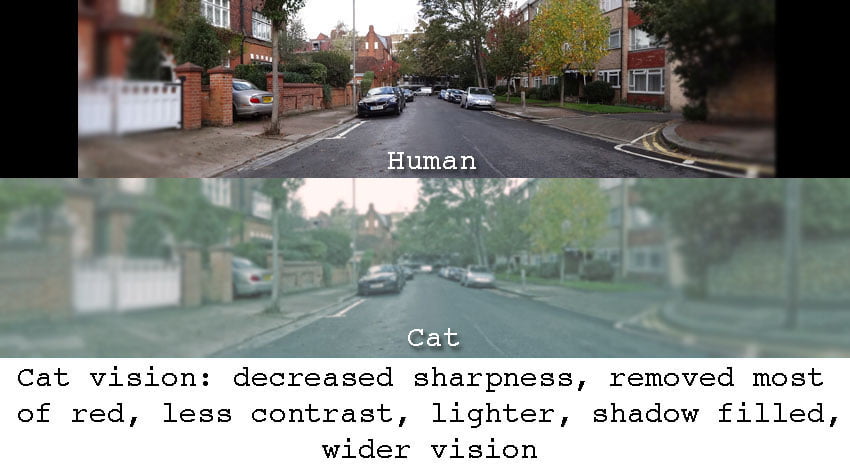Introduction: I was the first person to make these comparison point-of-view images. Everyone has followed. I used our knowledge of the cat’s eyesight to work it out. Enjoy. We cannot be absolutely certain that these images are entirely accurate but they should be pretty close. Remember too that cats have poor close-range eyesight partly because their muzzle gets in the way which is why domestic cats always gauge the edibility of cat food by smell primarily; almost exclusively in fact.

Click on the images to see them larger if you wish. You stay on this page.

The pictures show comparisons between cat and human vision. They show what a cat sees compared to what people see. This is speculative. It is careful guesswork based on what scientists have decided. We will probably never know for sure. Cats’ eyes are more attuned to seeing in low-light conditions for hunting at dawn and dusk where they need only one-sixth the light we do to see things and the same level of movement and detail.
The interesting point about trying to show what a cat sees is that we don’t know how the cat’s brain processes the information that the eye sends it. We are mainly focusing on the structure of the eye including the light sensitive cells in the retina. It is generally agreed today that the cat does not register reds or colors akin to red. For that reason, daytime cat vision should be bluish. However, the cat’s brain probably processes the bluish caste out leaving the image neutral, which is what I did.
The pictures are based on the following differences:
Cats’ eyes are designed to pick up movement in low light conditions because they mainly hunt at dusk and dawn, resulting in light sensitive eyes but eyes that focus less well (less sharp) and which register colour less well. Cats see “blue and yellow colors, but not red, orange or brown”2. In a previous post on this subject I stated that cats were “red color blind or perhaps red-green color blind”, which, however, is more or less the same thing. However, people are not sure how good a cat’s color vision is. In the past experts have stated that cats were colorblind.
Dr Morris is Catwatching (published 1986) says that “Recent studies have been able to prove that cats can distinguish between red and green, red and blue, red and grey, green and blue, green and grey, blue and grey, yellow and blue, and yellow and grey. Whether they can distinguish between other pairs of colours is still in dispute.”
He also says that in the early days it was believed that cats were colourblind and one authority reworked a popular saying with the words: “Day and night, all cats see grey”.
A cat’s eyes are much larger than ours relative to head size, and have better peripheral vision because they are more forward in the head than ours. Cats see 200 degrees compared to the 180 degrees of people. Although a simple test confirms that at the outer reaches of peripheral human vision it is next to useless. I would suggest that human peripheral vision is nearer 120-160 degrees. One source1 says 120º. Let’s just say that cats have more peripheral vision and leave it at that.
Some more on peripheral vision:
Of course, both for cats and humans, the peripheral part of our vision is blurred. Apparently, a cat’s eyes are more deeply recessed but I am not sure about that. Cats also have less good vision at a distance.
To summarise in plain language:
| PROPERTY | CAT | HUMAN |
| Colour | Weaker colour than human | Good colour – better than cat |
| Peripheral | Very good 200º | Less good than cat at 120-180º |
| Sharpness | Average – worse than human | Good – better than cat |
| Night vision | Excellent – much better than human | Much worse than cat |
Refs:
- Wikipedia.
- Popular Science – see their examples which are probably a bit better.
- Nighttime picture by byJoeLodge
- Note: My thanks to Ruth aka Kattaddorra for showing me the Popular Science page.


Yes, a bit softer but not bad. Good enough to recognise their owner at 40 yards at least. I guess the point is that this is speculative based on what we know about cat eyesight.